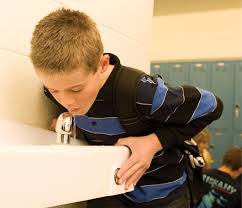District Releases Report on School Water Quality
- Thursday, 27 October 2016 11:06
- Last Updated: Thursday, 27 October 2016 11:20
- Published: Thursday, 27 October 2016 11:06
- Joanne Wallenstein
- Hits: 4094
 Ever since high lead levels were found in drinking fountains and sinks at Davis Elementary School in nearby New Rochelle, Scarsdale parents have asked questions about the safety of the drinking water in their schools.
Ever since high lead levels were found in drinking fountains and sinks at Davis Elementary School in nearby New Rochelle, Scarsdale parents have asked questions about the safety of the drinking water in their schools.
This week, Stuart Mattey, Assistant Superintendent for Business for the Scarsdale School District released the results of tests of water at all district schools done in March, 2016 that showed that with a few exceptions the 309 samples pulled from all schools were in compliance with EPA regulations.
However, the engineers did find that a number of sinks failed on the first draw but met standards after a 30 second flush. A few failed after the second draw and were taken out of service until filters could be installed. These locations included two sinks in the Cooper House lunchroom at the Middle School as well as a sink in the tech teacher's kitchen at the Middle School and the water fountain near the nurse's office at the Middle School.
At Fox Meadow, the water fountain next to the boiler room was also found to have unacceptable lead levels after the second draw.
The district remediated all of these locations and engineers returned on May 7, 2016 and found lead levels to be acceptable.
Local resident and environmental attorney Thomas Giuffra reviewed the report and offered the following comment for Scarsdale10583:
I just had the opportunity to review the test data for the water in the schools. Initially, I would note that the Board has taken a very proactive approach to this potential problem.
I hope that it will institute at least an annual survey of the drinking water in the district buildings.
Overall, the testing is favorable. There were a few locations which were over the EPA limits, but not so much so that they would raise concerns of a greater problem. If there had been large numbers of test locations in the same building which exceeded actionable limits, that would be a cause for concern because the issue would not be localized. Thankfully, the failing results appear to be in individual test locations which indicates a very small area of possibly degrading pipes or lead solder leaching lead.
What is most striking is the impact that remediation had on the failing locations. All
of the failing areas passed once remediation methods were utilized. Lead in drinking water is very easily controlled with filtration. In contrast lead dust, is much more difficult to safely manage and control based on its very nature.
One of the most basic ways to protect against lead in drinking water is to only use water from the cold tap for cooking, drinking or mixing baby formula. Water from a hot tap will always contain higher levels of lead. Water filters are very good idea.







